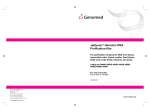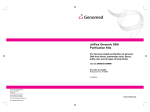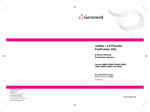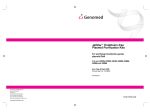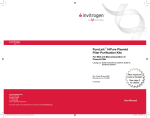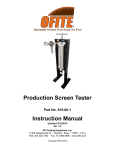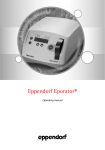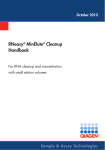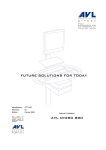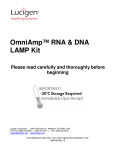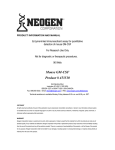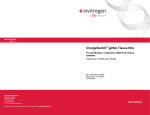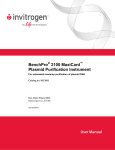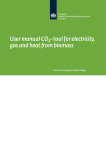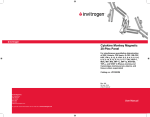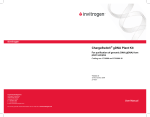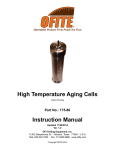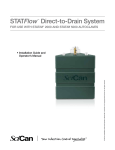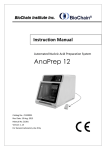Download JETQUICK Gel Extraction / PCR / General
Transcript
Genomed JetQuick™ DNA Purification Kits Gel Extraction, PCR Purification, and General DNA Clean-up Cat. nos. 410050, 410250, 420050, 420250, 430050, and 430250 Rev. Date: 21 April 2010 Manual Part no.: 70-15013 MAN0001740 Corporate Headquarters Genomed GmbH Poststr. 22 D-32584 Löhne, Germany Tel:+49-(0)5732-904700 Fax:+49-(0)5732-9047010 [email protected] www.genomed-dna.com User Manual ii Table of Contents Kit Contents and Storage ....................................................................................... iv Kit Specifications ....................................................................................................vii PCR Purification .......................................................................... 1 System Overview...................................................................................................... 1 Experimental Overview .......................................................................................... 3 PCR Purification Procedure.................................................................................... 4 Troubleshooting........................................................................................................ 8 Gel Extraction .............................................................................. 9 System Overview...................................................................................................... 9 Experimental Overview ........................................................................................ 11 Gel Extraction Procedure ...................................................................................... 12 Troubleshooting...................................................................................................... 17 General DNA Clean-Up.............................................................. 18 System Overview.................................................................................................... 18 Experimental Overview ........................................................................................ 19 General DNA Clean-Up Procedure..................................................................... 20 Troubleshooting...................................................................................................... 24 Appendix .................................................................................... 25 Estimating DNA Yield and Quality .................................................................... 25 Accessory Products ................................................................................................ 27 Technical Support................................................................................................... 28 Purchaser Notification........................................................................................... 29 iii Kit Contents and Storage Types of Kits This manual is supplied with the following products. Product Quantity Cat. no. JetQuick™ PCR Purification Spin Kit ™ JetQuick Gel Extraction Spin Kit ™ JetQuick General DNA Clean-up Kit 50 410050 250 410250 50 420050 250 420250 50 430050 250 430250 Intended Use For research use only. Not intended for human or animal diagnostic or therapeutic uses. JetQuick™ PCR Purification Spin Kit Contents The components included in the JetQuick™ PCR Purification Spin Kit are listed below. Store all components at room temperature. Component Binding Buffer (H1) Wash Buffer (H2) TE Buffer Cat. No. (Quantity) 410050 (50 preps) 410250 (250 preps) 22 mL 110 mL 12.8 mL 60 mL 10 mL 22 mL Spin Columns 50 each 250 each Receiver Tubes 50 each 250 each Continued on next page iv Kit Contents and Storage, Continued JetQuick™ Gel Extraction Spin Kit Contents The components included in the JetQuick™ Gel Extraction Spin Kit are listed below. Store all components at room temperature. Component Cat. No. (Quantity) 420050 (50 preps) 420250 (250 preps) Gel Solubilization Buffer (L1) 100 mL 500 mL Wash Buffer (L2) 12.8 mL 60 mL TE Buffer 10 mL 22 mL Spin Columns 50 each 250 each Receiver Tubes 50 each 250 each JetQuick™ General DNA Clean-up Kit Contents The components included in the JetQuick™ General DNA Clean-up Kit are listed below. Store all components at room temperature. Component Cat. No. (Quantity) 430050 (50 preps) 430250 (250 preps) 22 mL 110 mL 12.8 mL 60 mL TE Buffer 10 mL 22 mL Spin Columns 50 each 250 each Receiver Tubes 50 each 250 each Binding Buffer (M1) Wash Buffer (M2) Continued on next page v Kit Contents and Storage, Continued Buffer Composition The composition of buffers included in the JetQuick™ Kits is listed below. Kit Buffer Composition Binding Buffer (H1) When reconstituted, contains Tris-HCl, guanidine hydrochloride, isopropanol and EDTA Wash Buffer (H2) When reconstituted, contains Tris-HCl, ethanol, NaCl, and EDTA JetQuick™ Gel Extraction Spin Kit Gel Solubilization Buffer (L1) Contains guanidine isothiocyanate Wash Buffer (L2) When reconstituted, contains Tris-HCl, ethanol, NaCl, and EDTA JetQuick™ General DNA Clean-up Kit Binding Buffer (M1) When reconstituted, contains Tris-HCl, guanidine hydrochloride, isopropanol and EDTA Wash Buffer (M2) When reconstituted, contains Tris-HCl, ethanol, NaCl, and EDTA ™ JetQuick PCR Purification Spin Kit vi Kit Specifications JetQuick™ PCR Purification Spin Kit JetQuick™ Gel Extraction Spin Kit The specifications for the JetQuick™ PCR Purification Spin Kit are listed below. Time required 5 minutes Column Reservoir Capacity 600 μL Centrifuge Compatibility >12,000 × g Elution Volume 50 μL DNA Yield Up to 20 μg DNA Recovery Up to 95% (depending on DNA fragment size) DNA Fragment Size 80 bp to 20 kb Primer Removal >99.8% The specifications for the JetQuick™ Gel Extraction Spin Kit are listed below. Time required 25 minutes Starting Material ≤400 mg agarose gel slice Binding Capacity ~20 μg DNA per column Column Reservoir Capacity 600 μL Centrifuge Compatibility >12,000 × g Elution Volume 50 μL DNA Recovery Up to 95% (depending on DNA fragment size) DNA Fragment Size 40 bp to 10 kb Continued on next page vii Kit Specifications, Continued JetQuick™ General DNA Clean-up Kit viii The specifications for the JetQuick™ General DNA Clean-up Kit are listed below. Time required 5 minutes Column Reservoir Capacity 600 μL Centrifuge Compatibility >12,000 × g Elution Volume 50 μL DNA Yield Up to 20 μg DNA Recovery Up to 95% (depending on DNA fragment size) DNA Fragment Size 80 bp to 20 kb Enzyme removal (e.g., T4 DNA ligase, Taq DNA polymerase, restriction enzymes) no detectable activity PCR Purification System Overview About the Kit The JetQuick™ PCR Purification Spin Kit provides a simple and reliable method to isolate highly pure DNA on the basis of spin columns. It is designed for the rapid and efficient removal of primers, dNTPs, enzymes, and salts from PCR products. The JetQuick™ PCR Purification Spin Kit is based on the selective binding of dsDNA to a silica-based membrane in the presence of chaotropic salts. The PCR product is mixed with Binding Buffer (H1) to adjust conditions for subsequent dsDNA binding to the JetQuick™ Spin Column. The dsDNA binds to the silicabased membrane in the column and impurities are removed by thorough washing with Wash Buffer (H2). The dsDNA is then eluted in low salt Elution Buffer (Tris-HCl or TE) or water. Downstream Applications DNA purified using the JetQuick™ PCR Purification Spin Kit is as pure as CsCl purified DNA and is suitable for a number of downstream applications including: • Ligation • Restriction Analysis • Automated and manual DNA sequencing • PCR amplification • Cloning Continued on next page 1 System Overview, Continued Advantages 2 The advantages of using the JetQuick™ PCR Purification Spin Kit are: • Efficient removal of primers, dNTPs, salts, and enzymes without the need to perform ethanol precipitation or use solvents such as phenol or chloroform • Reliable performance of the purified PCR products in downstream applications • Not sensitive to gelatin or detergents such as NP-40 or Triton X-100 (at concentrations <0.1%) • May be used to isolate dsDNA fragments >100 bp Experimental Overview Introduction The flow chart below provides an overview for purifying DNA from Polymerase Chain Reactions using the JetQuick™ PCR Purification Spin Kit. Vacuum Centrifugation Add appropriate Binding Buffer with isopropanol to the PCR products Add appropriate Binding Buffer with isopropanol to the PCR products Apply sample to JetQuickTM PCR Spin Column in a Receiver Tube Apply sample to JetquickTM Spin Column attached to vacuum manifold Wash column with Wash Buffer Wash column with Wash Buffer SPIN SPIN Elute DNA into a new microcentrifuge tube SPIN Elute DNA into a new microcentrifuge tube 3 PCR Purification Procedure Introduction The PCR purification procedure is designed for purifying up to 20 μg dsDNA using a centrifuge (see page 5) or vacuum manifold (see page 6) in ~5 minutes. Materials Supplied by the User • Isopropanol • 96–100% ethanol Before Starting Method for Purifying DNA • Microcentrifuge capable of centrifuging at >12,000 × g • Vacuum manifold such as the EveryPrep™ Universal Vacuum Manifold (for Purification Procedure Using Vacuum only, see page 27 for ordering information) • DNase-free pipettes and tips • Reconstitute Binding Buffer (H1) with isopropanol according to the instructions on the label of the bottle. Store reconstituted Binding Buffer (H1) at room temperature. • Reconstitute Wash Buffer (H2) with absolute ethanol (96–100%) according to the instructions on the label of the bottle. Store reconstituted Wash Buffer (H2) at room temperature. • To purify DNA using centrifugation, proceed to page 5. • To purify DNA using vacuum, proceed to page 6. Continued on next page 4 PCR Purification Procedure, Continued Purification Procedure Using Centrifugation 1. Add 4 volumes of Binding Buffer (H1) to 1 volume of PCR sample. Mix well. Note: When PCR assays >100 μL are used, scale up Buffer H1 proportionally and maintain the 4:1 ratio of Buffer H1:PCR Sample. In this case, multiple loadings of the JetQuick™ Spin Column (Step 3, below) are required. 2. Place a JetQuick™ Spin Column into a 2 mL Receiver Tube. 3. Load the mixture from Step 1 into the prepared column. 4. Centrifuge at >12,000 × g for 1 minute. 5. Re-insert the column into the empty receiver tube and add 500 μL of reconstituted Wash Buffer (H2). 6. Centrifuge the column at >12,000 × g for 1 minute. 7. Discard the flow-through and place the JetQuick™ Spin Column back in the same 2 mL Receiver Tube. 8. Centrifuge again at >12,000 × g for 1 minute. Note: The additional centrifugation ensures that no residual ethanol, which may interfere with downstream applications, is carried over into the next step of the protocol. Buffer H2 is not completely removed unless the flow-through is discarded before centrifugation. 9. Place the JetQuick™ Spin Column into a new 1.5 mL microcentrifuge tube (not supplied in the kit). 10. Add 50 μL of sterile water, TE Buffer, or 10 mM Tris-HCl, pH 8.0 to the center of the column. 11. Centrifuge at >12,000 × g for 2 minutes. The elution tube contains your purified PCR product. Remove and discard the column. Note: To obtain higher DNA concentrations, elute with 30 μL preheated (65°C to 70°C) elution buffer. Add the buffer directly onto the center of the silica membrane of the JetQuick™ Spin Column and let stand for 1 minute before centrifugation. Preheated elution buffer is recommended to elute PCR fragments >5kb. Continued on next page 5 PCR Purification Procedure, Continued Purification Procedure Using Vacuum Perform all vacuum operations at room temperature. 1. Add 4 volumes of Binding Buffer (H1) to 1 volume of amplification reaction and mix thoroughly. Note: When PCR assays >100 μL are used, scale up Buffer H1 proportionally, maintaining the 4:1 ratio of Binding Buffer:PCR Sample. In this case, multiple successive loadings of the column (Step 3, below) are required. 2. Assemble the vacuum manifold according to the manufacturer’s instructions and attach a JetQuick™ Spin Column to the vacuum manifold. 3. Pipette the DNA sample (Step 1, above) onto the center of the silica membrane of the JetQuick™ Spin Column. 4. Apply vacuum (−200 to −650 mbar) until all liquid passes through the column and then turn off the vacuum source. 5. Add 500 μL Wash Buffer (H2) containing ethanol (page 4). 6. Apply vacuum as described in Step 4. Remove the column from the vacuum and place it into a 2 mL Receiver Tube. 7. Centrifuge the column with the Receiver Tube at maximum speed for 1 minute to remove any residual Wash Buffer (H2) and ethanol. Discard the flow-through and the Receiver Tube. 8. Place the JetQuick™ Spin Column into a new 1.5 mL microcentrifuge tube (not supplied in the kit) and add 50 μL of sterile water, TE Buffer, or 10 mM Tris-HCl, pH 8.0 to the center of the column. 9. Centrifuge at >12,000 × g for 2 minutes. The elution tube contains your purified PCR product. Discard the column. Note: A higher DNA concentration is obtained if the elution is performed with only 30 μL of elution buffer. In this case, preheat the elution buffer to 65°C–70°C, add the buffer directly onto the center of the spin column and let stand for 1 minute before centrifugation. Continued on next page 6 PCR Purification Procedure, Continued Storing DNA • Store purified DNA at 4°C for immediate use. • Aliquot DNA and store at –20°C for long-term storage. • Store DNA eluted in water at –20°C. • Avoid repeated freezing and thawing of DNA. 7 Troubleshooting Introduction Problem Low DNA yield Review the information below to troubleshoot your experiments with the JetQuick™ PCR Purification Spin Kit. Cause Insufficient amplification Incorrect binding conditions Incomplete DNA elution Inhibition of enzymatic reaction DNA fragment is too large Residual ethanol in the purified DNA Residual salt in the purified DNA 8 Solution Check amplicon on gel to verify the PCR product prior to purification. For efficient DNA binding, always mix 1 volume of PCR assay with 4 volumes of Binding Buffer (H1). Add preheated Elution Buffer (65°C to 70°C) directly onto the center of the silica matrix of the spin column and let it stand for 1 minute. Centrifuge at >12,000 × g for 1 minute. Use preheated Elution Buffer (as described above). Traces of ethanol from the Wash Buffer (H2) can inhibit downstream enzymatic reactions. To remove Wash Buffer (H2), discard the Wash Buffer flow-through from the Receiver Tube. Place the column into the Receiver Tube and centrifuge the column at >12,000 × g for 2–3 minutes to completely dry the column. Use water or 10 mM Tris-HCl, pH 8.0 (no EDTA) for elution. Gel Extraction System Overview About the Kit The JetQuick™ Gel Extraction Spin Kit is used for the rapid and efficient purification of DNA fragments from TAE or TBE agarose gels. DNA fragments up to 10 kb are optimally purified, although DNA fragments >10 kb may be purified with lower DNA recovery. Extract DNA by first excising and dissolving the gel (pages 12–13) and then purify the DNA by centrifugation (pages 14–15) or vacuum (see pages 15–16) using JetQuick™ silica membrane-based columns. Note: The JetQuick™ Gel Extraction Spin Kit is not designed to purify supercoiled plasmid DNA or genomic DNA from agarose gels. Only linear DNA fragments are purified from gels using this kit. Advantages Advantages of using the JetQuick™ Gel Extraction Spin Kit are: • Purification of DNA fragments from TAE and TBE agarose gels of various percentages and melting points • Procedure is complete in less than 25 minutes • Efficient purification of DNA fragments from 40 bp to 10 kb from gels • High recovery (85–95%) of DNA fragments • High binding column capacity of up to 20 μg DNA • Ensure that the DNA fragment of interest is completely separated from other DNA fragments on the agarose gel. • Each JetQuick™ Spin Column can purify up to 20 μg of DNA. If you wish to purify a larger amount of DNA, use several JetQuick™ Spin Columns. For best results, use one JetQuick™ Spin Column per 10 μg of DNA fragment loaded onto the gel. Continued on next page 9 MEND ION AT RECOM System Overview, Continued Experimental Summary 10 Follow the recommendations below to obtain the best results: • To minimize DNA degradation, always wear gloves and use a clean razor blade to cut the gel slice. • Maintain a sterile working environment when handling DNA to avoid any contamination from DNases. • Ensure that no DNase is introduced into the sterile buffers supplied with the kit. • Make sure all equipment that comes in contact with DNA is sterile, including pipette tips and tubes. To purify DNA fragments from agarose gels using the JetQuick™ Gel Extraction Spin Kit: 1. Dissolve an excised gel piece using Gel Solubilization Buffer (L1). 2. Purify and elute the DNA fragment using centrifugation or vacuum. 3. Place the dissolved gel piece into a JetQuick™ Spin Column containing a silica membrane and allow the DNA to bind the membrane. 4. Wash the membrane with Wash Buffer (L2) containing ethanol to remove impurities. 5. Elute the purified DNA using Elution Buffer (TE Buffer). The purified DNA is suitable for use in a wide variety of downstream applications. Experimental Overview Introduction The flow chart below provides an overview for purifying DNA fragments from agarose gels using the JetQuick™ Gel Extraction Kit. First, excise and dissolve the gel (pages 12–13). To purify DNA using centrifugation, see page 14. To purify DNA using vacuum, see page 15. 15 MIN 15 MIN L L L 2 MIN L 2 MIN 11 Gel Extraction Procedure Introduction The Gel Extraction procedure described on pages 12–16 is designed for purifying up to 20 μg dsDNA using centrifugation or a vacuum manifold in ~25 minutes. Materials Supplied by the User • 96–100% ethanol • Agarose gel containing the DNA fragment • Weighing paper or weigh trays • Scale (sensitive to 0.001 g) • Water bath or heat block set at 50°C • 1.5 mL or 5 mL polypropylene microcentrifuge tubes • Clean, sharp razor blade • Vacuum manifold such as the EveryPrep™ Universal Vacuum Manifold (for Purification Using Vacuum, only, see page 27 for ordering information) Excising the gel After completing agarose gel electrophoresis: 1. Excise the area of the gel containing your desired DNA fragment using a clean, sharp razor blade. Minimize the amount of agarose surrounding the DNA fragment. 2. Weigh the gel slice containing the DNA fragment using a scale sensitive to 0.001 g, and then place the gel into a 1.5 or 5.0 mL microcentrifuge tube as described on the next page. Note: The maximum amount of starting material (gel) is 400 mg per tube. If your gel slice exceeds 400 mg, cut the gel into smaller slices so that no one piece exceeds 400 mg. Place each additional gel slice into separate microcentrifuge tubes. For highest DNA purity, use 100 mg agarose gel slices per extraction. 3. Proceed to Dissolving the Gel, next page. Continued on next page 12 Gel Extraction Procedure, Continued Gel Solubilization Buffer (L1) contains guanidine isothiocyanate. Use proper precautions when handling. Dissolving the Gel 1. For ≤2% agarose gels: • Place up to 400 mg of the excised gel containing the DNA fragment (above) into a 1.5 mL polypropylene microcentrifuge tube. • Add 3 volumes Gel Solubilization Buffer (L1) for every 1 volume of gel (e.g., add 1.2 mL Buffer L1 for a 400 mg gel piece). For >2% agarose gels: • Place up to 400 mg of the excised gel containing the DNA fragment (see above) into a 5 mL polypropylene microcentrifuge tube. • Add 6 volumes Gel Solubilization Buffer (L1) for every 1 volume of gel (e.g., add 2.4 mL Buffer L1 for a 400 mg gel piece). 2. Place the tube(s) containing your gel slice and Buffer L1 (Step 1) into a 50°C water bath or heat block. 3. Incubate at 50°C for 15 minutes. Invert the tube by hand every 3 minutes to mix and ensure gel dissolution. Note: Complete dissolution of the agarose gel slice is critical. Once the gel slice appears dissolved, incubate the gel slice for an additional 5 minutes at 50°C. High concentration gels (>2% agarose) or large gel slices may take 20–30 minutes to dissolve. Cutting larger gel slices into smaller pieces will enhance solubilization. 4. Proceed to Purification Using Centrifugation, next page or Purification Using Vacuum, page 15. Continued on next page 13 Gel Extraction Procedure, Continued Purification Using Centrifugation The bottle of Buffer L2 contains concentrated buffer solution. Before beginning, add absolute ethanol (96–100%) as directed on the label of the bottle. Store reconstituted Wash Buffer (L2) at room temperature. 1. Place a JetQuick™ Spin Column into a 2 mL Receiver Tube. Pipette the dissolved gel piece containing the DNA fragment of interest (Step 3, previous page) onto the JetQuick™ Spin Column. Note: Do not load >400 mg agarose per JetQuick™ Spin Column. The maximum column capacity is 600 μL; for larger sample volumes, multiple loadings are necessary. 2. Centrifuge at >12,000 × g for 1 minute. Discard the flowthrough and replace the JetQuick™ Spin Column into the 2 mL Receiver Tube. Note: For downstream applications including sequencing, in vitro transcription, or microinjection, or if the weight of the initial agarose gel slice is >250 mg, wash the DNA with 500 μL Buffer L1. Incubate for 1 minute at room temperature before centrifuging again at >12,000 × g for 1 minute. 3. Add 500 μL Wash Buffer (L2), containing ethanol to the JetQuick™ Spin Column. 4. Centrifuge at >12,000 × g for 1 minute. Discard the flowthrough and replace the column into the Receiver Tube. 5. Centrifuge again at maximum speed for 1 minute to remove any residual Wash Buffer (L2) and ethanol. Note: Discard the flow-through before centrifugation to remove residual Wash Buffer (L2). The additional centrifugation step assures that no residual ethanol is carried over into the next step. 6. Discard the Receiver Tube and place the JetQuick™ Spin Column into a clean 1.5 mL microcentrifuge tube. Continued on next page 14 Gel Extraction Procedure, Continued Purification Using Centrifugation Continued 7. Add 50 μL of sterile water, 10 mM Tris-HCl, pH 8.0, or TE Buffer to the center of the JetQuick™ Spin Column. 8. Centrifuge at >12,000 × g for 2 minutes. The tube contains the purified DNA. Discard the column. Note: To obtain higher DNA concentrations, elute with only 30 μL of preheated (65°C to 70°C ) elution buffer, dispensed directly onto the center of the membrane. In this case, let stand for 1 minute before centrifugation. 9. Purification Using Vacuum Store DNA as indicated on page 16. Before beginning, add ethanol to the Wash Buffer (L2). Perform all vacuum operations at room temperature. 1. Assemble the vacuum manifold according to the manufacturer’s instructions. 2. Attach a JetQuick™ Spin Column to the vacuum manifold. 3. Pipette the dissolved gel piece containing the DNA fragment of interest (Step 3, page 13) onto the center of the silica membrane of the JetQuick™ Spin Column. 4. Apply vacuum (−200 to −650 mbar) until all liquid passes through the column, and then switch off the vacuum source. Note: Do not load more than 400 mg agarose per column. 5. Optional Column Wash: Add 500 μL Gel Solubilization Buffer (L1) to the center of the JetQuick™ Spin Column. Let stand for 1 minute. Apply vacuum (−200 to −650 mbar) until all liquid passes through the column, and then switch off the vacuum source. Continued on next page 15 Gel Extraction Procedure, Continued Purification Using Vacuum, Continued 6. Add 500 μL Wash Buffer (L2) containing ethanol to the center of the JetQuick™ Spin Column. 7. Apply vacuum (−200 to −650 mbar) until all liquid passes through the column, and then switch off the vacuum source. 8. Remove the JetQuick™ Spin Column from the vacuum and place it into a 2 mL Receiver Tube. 9. Centrifuge the column with the Receiver Tube at maximum speed for 1 minute to remove any residual Wash Buffer and ethanol. Discard the Receiver Tube with the flow-through. 10. Place the JetQuick™ Spin Column into a clean 1.5 mL recovery tube. 11. Add 50 μL of sterile water (or TE Buffer or 10 mM Tris-HCl, pH 8.0) to the center of the JetQuick™ Spin Column. Note: Higher DNA concentrations are obtained if the elution is performed with only 30 μL of elution buffer preheated to 65°C –70°C. Add the buffer onto the center of the silica matrix of the spin column. 12. Incubate for 1 minute at room temperature. 13. Centrifuge at >12,000 × g for 2 minutes to elute the purified DNA into the recovery tube. Discard the JetQuick™ Spin Column. Storing DNA 16 • Store the purified DNA at 4°C for immediate use. • Aliquot the DNA and store at –20°C for long-term storage. • Store DNA eluted in water at –20°C. • Avoid repeated freezing and thawing of DNA. Troubleshooting Introduction Problem Low DNA yield Inhibition of enzymatic reaction Review the information below to troubleshoot your experiments with the JetQuick™ Gel Extraction Spin Kit. Cause Incorrect ratio of gel to Gel Solubilization Buffer (L1) Incomplete solubilization of gel piece Solution Ensure that the correct volume of Gel Solubilization Buffer (L1) is added for every 1 volume of gel used, based on the agarose gel percentage (see page 13). Verify that the temperature of water bath or heat block is at 50°C. Cut large gel slices into several pieces to accelerate gel dissolution. Mix gel slice in Buffer L1 every 3 minutes during the dissolution step. Incomplete DNA elution Preheat Elution Buffer to 65°C to 70°C, add the buffer directly onto the center of the silica matrix of the JetQuick™ Spin Column, let stand for 1 minute. Centrifuge at >12,000 × g for 1 minute. DNA fragment is too large Use preheated elution buffer (as described above). Increase the incubation time for elution to >10 minutes. This kit is not designed to purify supercoiled plasmid DNA. Traces of ethanol from the Wash Buffer (L2) can inhibit downstream enzymatic reactions. To remove Wash Buffer (L2), discard Buffer L2 flow-through from the Receiver Tube. Place the column into the Receiver Tube and centrifuge at >12,000 × g for 3 minutes to completely dry the column. Use water or 10 mM Tris-HCl, pH 8.0 (no EDTA) for elution. DNA is supercoiled Residual ethanol in the purified DNA Residual salt in the purified DNA 17 General DNA Clean-Up System Overview About the Kit The JetQuick™ General DNA Clean-up Kit is used to purify DNA in less than 5 minutes. The DNA sample (e.g., crude plasmid preps, restriction, ligation or other enzymatic assay) is first adjusted to defined salt conditions. The DNA selectively binds to the silica membrane of a JetQuick™ Spin Column during centrifugation. After centrifugation, one wash is sufficient to remove nucleotides, enzymes, salts, dyes, residual RNA’s and other impurities. The purified DNA is eluted in TE Buffer or water and ready for downstream use. DNA can be purified by centrifugation (page 21) or vacuum (see page 22) using JetQuick™ silica membrane-based columns. Advantages 18 Advantages of using JetQuick™ General DNA Clean-up Kits are: • No phenol • No chloroform • Total salt, dye, and protein removal • Not sensitive to gelatin or detergents such as Triton X-100 (at concentrations <0.1%) or NP-40 Experimental Overview Introduction The flow chart below provides an overview for purifying DNA using the JetQuick™ General DNA Clean-up Kit. Purification may be performed using centrifugation or vacuum. Vacuum Method Centrifugation Method Add appropriate Binding Buffer to the DNA sample Add appropriate Binding Buffer to the DNA sample Apply sample to JetquickTM Spin Column in a Collection Tube Apply sample to JetquickTM Spin Column attached to vacuum manifold Wash column with Wash Buffer Wash column with Wash Buffer SPIN SPIN Elute DNA SPIN Elute DNA 19 General DNA Clean-Up Procedure Introduction The General DNA Clean-Up procedure described on pages 21–23 is designed for purifying up to 20 μg dsDNA using a centrifuge or vacuum manifold in ~5 minutes. Materials Supplied by the User • Isopropanol • 96–100% ethanol • Microcentrifuge capable of centrifuging at >12,000 × g • DNase-free pipettes and tips • DNA sample from enzymatic and or other in vitro assays (e.g., restriction enzyme digestion, ligation reaction) or plasmid DNA from crude minipreps • Vacuum manifold such as the EveryPrep™ Universal Vacuum Manifold, for Purification Procedure Using Vacuum only (see page 27 for ordering information) Before Starting Reconstitute Binding Buffer (M1) with isopropanol and Wash Buffer (M2) with absolute ethanol (96–100%) according to the instructions on the labels of the bottles. Store reconstituted Binding Buffer (M1) and Wash Buffer (M2) at room temperature. Reconstituted Binding Buffer (M1) contains guanidine hydrochloride and isopropanol. Always wear a lab coat, disposable gloves, and protective eyewear during handling. Do not add bleach or acidic solutions directly to solutions containing guanidine hydrochloride or sample preparation waste as it forms reactive compounds and toxic gases when mixed with bleach or acids. Continued on next page 20 General DNA Clean-Up Procedure, Continued Purification Procedure Using Centrifugation 1. Add 4 volumes of Binding Buffer (M1) to 1 volume of DNA sample. Mix well. Note: When samples >100 μL are used, scale up the volume of Buffer M1 proportionally, maintaining the ratio of Buffer M1:DNA sample (4:1). In this case, multiple loadings of the column (Step 3, below), are required. 2. Place a JetQuick™ Spin Column into a 2 mL Receiver Tube. 3. Load the mixture from Step 1 into the prepared column. 4. Centrifuge at >12,000 × g for 1 minute. 5. Discard the flow-through. 6. Re-insert the column into the empty Receiver Tube and add 500 μL of reconstituted Wash Buffer (M2). 7. Centrifuge the column at >12,000 × g for 1 minute. 8. Discard the flow-through and place the JetQuick™ Spin Column back in the same Receiver Tube. 9. Centrifuge again at >12,000 × g for 1 minute. Note: Residual buffer (M2) will not be completely removed unless the flow-through is discarded before this additional centrifugation. Buffer M2 contains ethanol, and residual ethanol may interfere with subsequent reactions. The additional centrifugation assures that no residual ethanol is carried over into the next step of the protocol. 10. Place the JetQuick™ Spin Column into a new 1.5 mL microcentrifuge tube. 11. Add 50 μL of sterile water, TE Buffer, or 10 mM Tris-HCl, pH 8.0, to the center of the column. 12. Centrifuge at >12,000 × g for 2 minutes. Note: A higher DNA concentration is obtained if the elution is performed with only 30 μL of elution buffer. In this case, preheat the elution buffer to 65°C–70°C, add the buffer directly onto the center of the spin column and let stand for 1 minute before centrifugation. Continued on next page 21 General DNA Clean-Up Procedure, Continued Purification Procedure Using Vacuum 1. Add 4 volumes of Binding Buffer (M1) to 1 volume of DNA sample. Mix well. Note: When samples >100 μL are used, scale up the volume of Buffer M1 proportionally, maintaining the ratio of Buffer M1:DNA sample (4:1). In this case, multiple loadings of the column (Step 4, below), are required. 2. Assemble the vacuum manifold according to the manufacturer’s instructions. 3. Attach a column to the vacuum manifold. 4. Pipette the sample onto the membrane of the column. Apply vacuum (−200 to −650 mbar) until all liquid passes through the column, and then switch off the vacuum source. 5. Add 500 μL Wash Buffer (M2) containing ethanol (see page 20) to the center of the JetQuick™ Spin Column. 6. Apply vacuum (−200 to −650 mbar) until all liquid passes through the column, and then switch off the vacuum. Remove the JetQuick™ Spin Column from the vacuum and place it into a 2 mL Receiver Tube. 7. Centrifuge the column with the Receiver Tube at maximum speed for 1 minute to remove any residual Wash Buffer (M2) and ethanol. Discard the flow-through and the Receiver Tube. 8. Place the JetQuick™ Spin Column into a new 1.5 mL microcentrifuge tube. Add 50 μL of sterile water, TE Buffer, or 10 mM Tris-HCl, pH 8.0, to the center of the column. 9. Centrifuge at >12,000 × g for 2 minutes. Note: A higher DNA concentration is obtained if the elution is performed with only 30 μL of elution buffer. In this case, preheat the elution buffer to 65°C–70°C, add the buffer directly onto the center of the spin column and let stand for 1 minute before centrifugation. Continued on next page 22 General DNA Clean-Up Procedure, Continued Storing DNA • Store the purified DNA at 4°C for immediate use. • Aliquot the DNA and store at –20°C for long-term storage. • Store DNA eluted in water at –20°C. • Avoid repeated freezing and thawing of DNA. 23 Troubleshooting Introduction Review the information below to troubleshoot your experiments with the JetQuick™ General DNA Clean-up Kit. Problem Cause Solution Low DNA yield Insufficient starting material Verify the quantity of DNA in your sample prior to purification. Incorrect binding conditions For efficient DNA binding, always mix 1 volume of DNA sample with 4 volumes of Binding Buffer (M1). Incomplete DNA elution Add preheated Elution Buffer (65°C to 70°C) directly onto the center of the silica matrix of the spin column and let stand for 1 minute. Centrifuge at >12,000 × g for 1 minute. DNA fragment is too large Use preheated Elution Buffer for all fragments >7.5kb and add the buffer directly onto the center of the silica matrix of the spin column. Let stand for 1 minute before centrifuging at >12,000 × g for 1 minute. Residual ethanol in the purified DNA Traces of ethanol from the Wash Buffer (M2) can inhibit downstream enzymatic reactions. Inhibition of enzymatic reaction To remove Buffer M2, discard Wash Buffer flow-through from the Receiver Tube. Place the column into the Receiver Tube and centrifuge the column at >12,000 × g for 2–3 minutes to completely dry the column. Residual salt in the purified DNA 24 Use water or 10 mM Tris-HCl, pH 8.0 (no EDTA) for elution. Appendix Estimating DNA Yield and Quality DNA Yield Perform DNA quantitation using Quant-iT™ DNA Assay Kits, agarose gel electrophoresis, or spectrophotometer. Quant-iT™ DNA Assay Kits The Quant-iT™ DNA Assay Kits (see page 27 for ordering information) provide a rapid, sensitive, and specific method for dsDNA quantitation with minimal interference from RNA, protein, ssDNA (primers), and other common contaminants that affect UV absorbance. The kit contains a state-of-the-art quantitation reagent, prediluted standards for standard curve, and a pre-made buffer. For optimal results, perform the quantitation using Invitrogen’s Qubit® Fluorometer (page 27). Quant-iT™ DNA Assay Kits also work with standard fluorescent microplate readers. Follow the manufacturer’s recommendations to perform the assay. Agarose Gel Electrophoresis To estimate the yield using agarose gel electrophoresis, compare the purified PCR product to known quantities of a DNA fragment with the same size. Compare the band intensity of the purified PCR product to the DNA fragment used as a standard. Continued on next page 25 Estimating DNA Yield and Quality, Continued DNA Yield, Continued UV Spectrophotometer To estimate DNA yield by spectrophotometer, measure the UV absorbance of the sample at 260 nm. Dilute the sample in Tris-HCl pH 7.5–8.5. Calculate quantity with the following formula: A260 × dilution factor × ε Where A260 is the absorbance at 260 nm, and ε is the molar extinction coefficient (for dsDNA, ε = 50; for, ssDNA ε = 33). Estimating DNA Quality DNA purified using JetQuick™ DNA Purification Kits has an OD A260/A280 value of >1.8 when samples are diluted in TrisHCl pH 7.5–8.5 indicating that the DNA is substantially free of contaminants that would otherwise affect UV absorbance. To confirm the integrity and the size of the purified DNA fragments, perform agarose gel electrophoresis. 26 Accessory Products Additional Products The table below lists additional products available from Invitrogen that may be used with JetQuick™ DNA Purification Kits. For more information about these products, visit www.invitrogen.com or contact Technical Support (page 28). Amount Cat. no. ™ Product 1,000 assays Q33120 ™ 1,000 assays Q33130 Qubit® Fluorometer 1 each Q32857 1 unit K211101 Quant-iT DNA Assay Kit, High Sensitivity Quant-iT DNA Assay Kit, Broad–Range ™ EveryPrep Universal Vacuum Manifold 27 Technical Support World Wide Web Contact Us Visit the website at www.genomed-dna.com for: • Technical resources, including manuals, MSDSs, FAQs • Complete technical support contact information • Access to the Online Catalog • Additional product information and special offers For more information or technical assistance, call, write, fax, or email. Additional international offices are listed on www.genomed-dna.com. GENOMED GmbH Poststr. 22 D-32584 Löhne Germany Tel: +49-(0)5732-904700 Fax: +49-(0)5732-9047010 E-mail: [email protected] 28 Purchaser Notification Limited Warranty GENOMED (a part of Life Technologies Corporation) is committed to providing our customers with high-quality goods and services. Our goal is to ensure that every customer is 100% satisfied with our products and our service. If you should have any questions or concerns about an Invitrogen product or service, contact our Technical Support Representatives. All GENOMED products are warranted to perform according to specifications stated on the certificate of analysis. The Company will replace, free of charge, any product that does not meet those specifications. This warranty limits the Company’s liability to only the price of the product. No warranty is granted for products beyond their listed expiration date. No warranty is applicable unless all product components are stored in accordance with instructions. The Company reserves the right to select the method(s) used to analyze a product unless the Company agrees to a specified method in writing prior to acceptance of the order. GENOMED makes every effort to ensure the accuracy of its publications, but realizes that the occasional typographical or other error is inevitable. Therefore the Company makes no warranty of any kind regarding the contents of any publications or documentation. If you discover an error in any of our publications, report it to our Technical Support Representatives. Life Technologies Corporation shall have no responsibility or liability for any special, incidental, indirect or consequential loss or damage whatsoever. The above limited warranty is sole and exclusive. No other warranty is made, whether expressed or implied, including any warranty of merchantability or fitness for a particular purpose. Continued on next page 29 Purchaser Notification, Continued Limited Use Label License No. 5: Invitrogen Technology The purchase of this product conveys to the buyer the nontransferable right to use the purchased amount of the product and components of the product in research conducted by the buyer (whether the buyer is an academic or for-profit entity). The buyer cannot sell or otherwise transfer (a) this product (b) its components or (c) materials made using this product or its components to a third party or otherwise use this product or its components or materials made using this product or its components for Commercial Purposes. The buyer may transfer information or materials made through the use of this product to a scientific collaborator, provided that such transfer is not for any Commercial Purpose, and that such collaborator agrees in writing (a) not to transfer such materials to any third party, and (b) to use such transferred materials and/or information solely for research and not for Commercial Purposes. Commercial Purposes means any activity by a party for consideration and may include, but is not limited to: (1) use of the product or its components in manufacturing; (2) use of the product or its components to provide a service, information, or data; (3) use of the product or its components for therapeutic, diagnostic or prophylactic purposes; or (4) resale of the product or its components, whether or not such product or its components are resold for use in research. For products that are subject to multiple limited use label licenses, the terms of the most restrictive limited use label license shall control. Life Technologies Corporation will not assert a claim against the buyer of infringement of patents owned or controlled by Life Technologies Corporation which cover this product based upon the manufacture, use or sale of a therapeutic, clinical diagnostic, vaccine or prophylactic product developed in research by the buyer in which this product or its components was employed, provided that neither this product nor any of its components was used in the manufacture of such product. If the purchaser is not willing to accept the limitations of this limited use statement, Life Technologies is willing to accept return of the product with a full refund. For information about purchasing a license to use this product or the technology embedded in it for any use other than for research use please contact Out Licensing, Life Technologies, 5791 Van Allen Way, Carlsbad, California 92008 or [email protected] ©2010 Life Technologies Corporation. All rights reserved. 30 Genomed Corporate Headquarters Genomed GmbH Poststr. 22 D-32584 Löhne, Germany Tel:+49-(0)5732-904700 Fax:+49-(0)5732-9047010 [email protected] www.genomed-dna.com User Manual








































